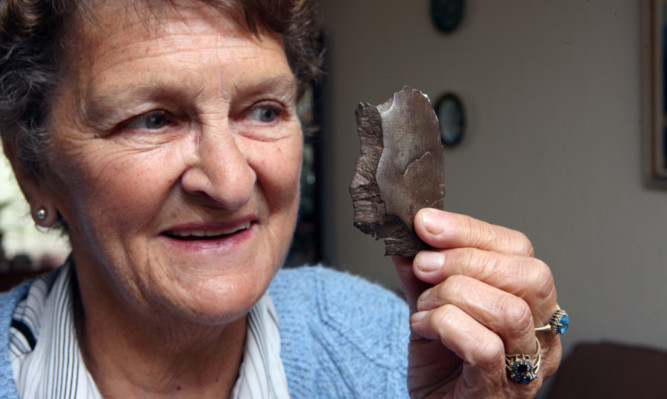A piece of shrapnel from one of a small number of bombs to fall on Perthshire during the Second World War has been offered to a museum.
Local woman Irene Shepherd had kept the shard as a family heirloom after it lodged in her father’s boot in the 1940s. But now she plans to hand it over to a museum almost 70 years after the war ended.
The explosive was dropped on Old Scone in the closing months of the conflict.
Locals, including Irene’s father Charles “Chick” Walker, converged on the field where the shell fell, just off the A93, to clear away the remains.
Mrs Shepherd, who now lives in Almondbank, said: “I would have been about nine. It was just before the war ended. It was just in the fields of Old Scone that they dropped them they just got rid of the bombs.
“I remember my dad telling us they were trying for the railway station and the searchlights got them and they made for, he thought, Scone Palace. It would have cut off a lot of things if they’d got the station.”
Mr Walker, who worked as a forester at Scone Palace, trekked the half mile from his cottage to the field, at the Blue Blanket Bend on the A93, to help.
His daughter said: “My dad was one of the ones who were clearing it and he came home that night and I remember him saying to my mum: ‘You’ll have to do something. I’ve hurt my foot along there’.
“They wore big boots in those days and this bit of bomb, which was so sharp, was stuck into his boot and was in at the thin bits going down to your heel.
“He said he hadn’t noticed it but it was so sore. He didn’t have far to walk from the corner at Old Scone to the cottage we were in.”
The shrapnel narrowly avoided being thrown out and was rescued by Mrs Shepherd.
She said: “It was put in a box and when they cleared the house they were going to throw it out, but I said I wanted it because I remembered it happening.
“I can remember the noise of the bomb. I can remember my dad flying up and down the lobby saying ‘We’re going to be hit, we’re going to be hit’ because you could hear the planes overhead.
“I’ve had it for a long time, just sitting in the china cabinet, and I thought someone else might like to know about it. I wondered if the museum might like it.”
Mrs Shepherd is to meet an expert at Perth Museum later this week to discuss handing over the fragment to its collection.
Perth and Kinross largely escaped bombing during the conflict, with efforts concentrated on cities.
A Courier article from May 24 1945 chronicled the damage done in Perthshire.
Despite more than 200 high-explosive bombs and hundreds of incendiaries falling on the area, not a single life was lost.
The first bombs to hit Perth, on June 25 1940, just missed Moncrieff tunnel. On the same night another shell, thought to have been intended for an electricity power plant, fell at Straloch.
The next night 30 incendiaries were dropped on the Craigend area of Perth, and eight high explosives at Kirkmichael.
The most widespread raid was on April 7 1941, when 15 separate locations were hit.
Photo by Phil Hannah
